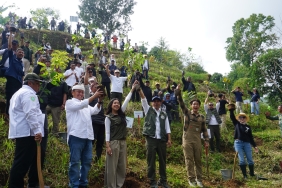FISHERMEN AND FISH IN THE HEART OF BORNEO
By: Shella Rimang
Journalist Suara Pemred
This article was written in conjunction with the Lake Sentarum Festival 2018 Pre-event
The tidal conditions of Lake Sentarum make residents who live in the lake area which is included in the Heart of Borneo region only recognize two seasons. The rainy or tidal season is known as the honey season and the dry season means fish season. In the season between rain and honeymoon, when the lake water begins to replenish, the aroma of fish still adorns the fishermen's village.
In fact, when just passing through the fishing village using a sepit, the most common transportation used in the lake area, the smell of salt-soaked fish mixed with the hot sun, still greets the sense of smell. Uniquely, fishermen in the Sentarum area still maintain local wisdom and preserve the surrounding environment by catching fish with traditional tools. Trawls and bubu are the most common fishing tools found along the lake's flow during the dry season.
Both fishing tools have the same raw material, namely small ropes. The method of manufacture is relatively the same, only in the bubu, the ropes are woven into the wood in the form of an equilateral rectangular box without a dividing wall. However, the two fishing tools that have existed for a long time will produce different catches. "If you install bubu, you can get up to 20-30 kilograms per harvest. But with trawls, you can't get that much, at most 10-20 kilograms," said Ahmad Rofa'i (70), a resident of Tekenang fishing village, last Wednesday (26/9).
The installation system in the lake area - which in the dry season forms small rivers - also has differences. Trawls can be set up every day, usually in a deep area in the middle of the river. While bubu, the installation system is more in the shallow area at the edge of the river. Harvesting is done every three days. The trick is that the bubu is left in the river first, three days later it is just lifted to take the fish.< br />
The catches obtained in the lake cannot be ensured to be the same every year. For example, this year, said Rofa'i, the catch is more than last year. The reason is that last year there was less biawan fish. While this year there are more biawan fish, other types of fish are somewhat reduced. Rofa'i, one of the fishermen who claims to have become friends with the water, said that in past years, the catch tended to be even smaller. "There has been no dry season for a long time. So, the fish went into the ground that was burned," he said while choosing salted fish to sell.
The amount of catch also depends on the season. Rofa'i relates the seasons he knows to the catch. During the dry season, the catch is plentiful. Midway between the dry season and the rainy season, the fish have started to decrease. Especially if it is high tide, the catch of fish becomes very small. "The most abundant fish here is biawan. There are no other fish. Biawan is available every day. It's just that the number of fish is uncertain," he said.
Different from bees, to get a lot of fish catches there are no special rituals performed. The catch is purely the effort of the fisherman and depends on the favor of the god of luck. Since Tekenang is a fishing village, the only source of income is fish. Therefore, the catch is usually immediately processed and distributed to other areas. There are fresh fish (packed in boxes with ice cubes), salted fish and salai (smoked fish). Especially for biawan fish, the eggs can be salted and sold separately.
Regarding the price of fish, especially salted fish, a response came from Abang Usman, a fisherman from Semangit Hamlet, Leboyan Village, Selimbau Subdistrict who also uses bubu more often to catch fish. According to him, in Semangit, there are several types of fish that are used as salted fish. Not only biawan, there are toman and lais. The fish will then be cleaned, soaked in salt water, and dried in the sun for at least four days. "When it's dry, (the price) can reach 30-40 a kilo," he said.





